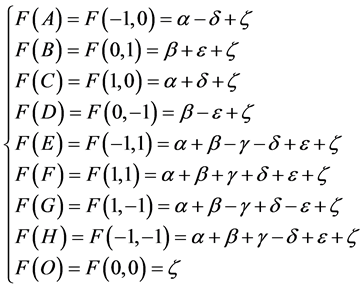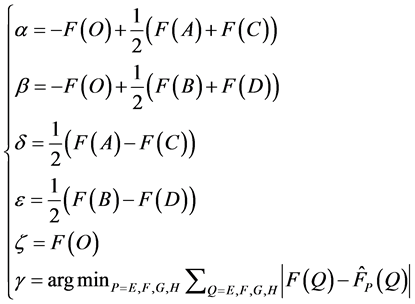1. 引言
视频编码技术是通过分析视频数据的特性,去除视频本身所包含的冗余信息,以达到数据压缩的一项数字媒体处理的关键性技术。HEVC [1] 作为高效视频标准(High Efficiency Video Coding),由ITU-T的VCEG和ISO/IEC的MPEG组织联合协作制定,是当今世界最为先进的视频编码标准之一,较之传统的H.264/AVC,编码效率提高一倍[2] 。
未经压缩的视频数据量是非常庞大的,给视频信息的存储与传输带来了极大的不便。近几十年来,随着人们对视频压缩技术的持续研究,相继推出了H.261、MPEG-1、MPEG-2、H.263、H.264等一系列优秀的编码标准,使得视频编码器的编码效率不断提高。为了满足人们对于视频内容分辨率、色彩饱和度不断提高的需求,HEVC、AVS2等新一代视频编码标准应运而生,针对高清视频的压缩性能尤为出色。
新一代视频编码标准HEVC采用了多项新的编码技术,在视频编码性能上有显著提高,但同时也引入了极高的计算复杂度,这十分不利于HEVC的实际应用,特别是实时性要求较高的场合。因此,研究新一代视频标准的快速算法,在保持性能的前提下,降低算法复杂度具有十分重要的研究意义。
运动估计作为HEVC编码器的关键技术之一,占用将近一半的编码时间[3] 。在运动估计的研究历程中,国内外学者提出了很多优秀算法,基本的算法如全搜索(Full Search, FS)算法,通过遍历搜索窗内的每一个点进行代价函数计算,选取代价最小的块为最佳匹配块,该方法匹配效果最好,但时间复杂度过高。其它方法如三步搜索法(Three Step Search, TSS)、四步搜索法(Four Step Search, FSS) [4] 、菱形搜索法(Diamond Search, DS) [5] 、六边形搜索法(Hexagon-Based Search, HEXBS) [6] 等算法大多是基于模板图案的搜索方法,相对全搜索可以节省90%以上的编码时间,但并不适应搜索窗尺寸较大的编码标准,且易陷入局部最优。为此,在HEXBS算法的基础上,UMHexagonS (非对称十字搜索与六边形网格搜索)算法[7] 对此加以改进,被广泛运用于H.264/AVC、AVS等视频编码标准中。
2. 相关工作
2.1. 视频编码中的运动估计技术
典型的视频编码系统,包含预测、变换、量化、熵编码等关键技术。预测技术利用视频内容的时域和空域相关性实现对当前编码块的预测,仅对当前块和预测块的残差信息、运动矢量等数据作进一步的处理,剔除了大量冗余信息,从而可以实现对视频内容的大幅度压缩。编码预测主要包括帧内预测和帧间预测两种方法。运动估计(Motion Estimation, ME)是帧间预测的重要组成部分,是编码系统中消除时域冗余、提高压缩比的最基本和最重要的关键技术,其中块匹配法(Block Match Algorithm, BMA)由于算法简单且易于硬件实现,被广泛应用于各视频编码标准中。块匹配法的基本思想是先将图像划分为许多子块,然后对当前帧中的每一块根据一定的匹配准则在前后多个参考帧的一定搜索范围内寻找出当前块的最佳匹配块,由此得到两者的相对位移,即当前块的运动矢量。在HEVC标准中,图像序列的当前帧被划分成互不重叠的最大为64 × 64大小的子块,每个子块还可以划分为更小的子块。对于当前块来说,只有运动估计所得运动矢量及当前块和预测块之间的残差信息,经过后续处理后才会被输出到码流中。由此可见,运动估计算法越完善,运动矢量估计越准确,预测误差越小,输出的比特流数据就越小,因此,高质量的运动估计算法是高效视频编码的前提和基础。此外,快速运动估计算法往往会受到搜索范围的影响,当搜索范围越小时,运动向量的预测越容易陷入局部最优,当搜索范围越大时,算法复杂度越高。寻找一个兼顾运算复杂度与精确度、且又不易于陷入局部最优的运动估计算法显得非常重要。
2.2. HEVC参考软件TZSearch算法
在HEVC标准的参考软件HM中,采用的运动估计方法是TZSearch [8] (如图1所示),TZSearch的起始点选择有三种可选方案,分别是:(1) 中值预测方案;(2) 当前预测块的左、上、右上三种模式的预测方案;(3) 零运动矢量的预测方案。具体的搜索方法包括两遍菱形搜索和一遍光栅搜索。其中,第一遍菱形搜索从步长为1开始,不断以2的倍数扩大,步长较小时采用4点的菱形搜索,步长较大时采用8点的菱形搜索,光栅搜索则按照步长为5的固定值,按照光栅的Z字型顺序搜索寻找匹配代价最小的块。
2.3. 代价函数模型
目前,衡量块匹配效果好坏的准则主要有平均绝对差(Mean Absolute Difference, MAD)、绝对误差和(Sum of Absolute Difference, SAD)、最小均方误差(Mean Squared Difference, MSD)、差值平方和(Sum of Squared Difference, SSD)、归一化相关函数(Normalized Cross-Correction Function, NCCF) 等几种。选择一个既能精确描述块之间的匹配程度,又能快速得到结果的匹配准则,将会极大地提高搜索速度,改进算法性能。
计算两个块大小相同的像素单元的平均绝对差MAD如公式(1)所示,是通过累加两个块中每个点的对应坐标像素值之差的绝对值并求取其平均值而得到的。式中M,N是匹配块的高度与宽度尺寸, 表示当前
表示当前 坐标下的像素值,
坐标下的像素值, 表示位移矢量。MAD的值越小,则匹配的效果越好,说明两个块的相关性越高。
表示位移矢量。MAD的值越小,则匹配的效果越好,说明两个块的相关性越高。
 (1)
(1)
由于MAD平均值的计算涉及乘除法运算,通常用绝对误差和SAD代替MAD,但不会影响匹配效果。SAD的计算方法见公式(2)。
 (2)
(2)
最小均方误差MSD的计算方法类似MAD,见公式(3),差别在于MSD所求的是方差的绝对值的平均值。MSD的值越小,则匹配的效果越好,说明两个块的相关性越高。
 (3)
(3)

Figure 1. The TZSearch algorithm in HM
图1. HM中的TZSearch算法
同样地,由于MSD平均值的计算也涉及乘除法运算,通常用差值平方和SSD来代替MSD,但不会影响匹配效果。SSD的计算方法见公式(4)。
 (4)
(4)
归一化相关函数NCCF对两个块的对应位置的像素值进行归一化,方法如公式(5)。归一化的值越大,匹配效果越好,说明两个块的相关性越高。NCCF的计算复杂度较高,实用性较差,仅应用于研究中。
 (5)
(5)
一般而言,在进行运动估计时,离最优匹配点越远,匹配误差值SAD越大,现有的整像素运动估计算法大都采用SAD来进行块匹配的计算。
3. 基于二次模型的运动估计快速算法
3.1. 模型介绍
对HEVC诸多测试序列的代价分布进行统计,整个搜索窗的代价分布接近一个连续的曲面。距离曲面的最小值,即最优点的距离越近,代价值越小。假设该曲面为一个二次曲面,利用数学方法求解二次曲面的极值点即为最优结果,该SAD的二次曲面可以用 来近似估计。
来近似估计。
在搜索窗内,以当前搜索范围的一半为初始步长R,选取围绕当前点的8个点,如图2所示,并分别为其分配虚拟坐标。其中当前点的虚拟坐标为O(0,0),水平与垂直方向上的四个点分别是A(−1,0)、B(0,1)、C(1,0)、D(0,−1),对角线方向上的四个点分别是E(−1,1)、F(1,1)、G(1,−1)、H(−1,−1),计算此9个点的SAD值。
将上述9个点的虚拟坐标以及SAD值带入公式 中,则可得到如下所示的结果:
中,则可得到如下所示的结果:
 (6)
(6)
因此,利用O、A、B、C、D、E、F、G、H九个点及其代价SAD值,即可计算出模型函数的所有参数,计算方法如下式所示:
 (7)
(7)
对方程 进行微分操作,当
进行微分操作,当 的x分量与y分量的偏导数都为0时,所得的点
的x分量与y分量的偏导数都为0时,所得的点 即为极值点。当
即为极值点。当 时,所得曲面为一个凹曲面,极值点即为极小值点,否则,为极大值点,具体的判断过程如下式所示:
时,所得曲面为一个凹曲面,极值点即为极小值点,否则,为极大值点,具体的判断过程如下式所示:
 (8)
(8)
由上式可知,极值点为极大值点时,丢弃该点,选择O、A~H中SAD值最小的点作为搜索结果 。
。
以上所得极值点的坐标乘以R得 ,该坐标为真实坐标。
,该坐标为真实坐标。
如图2中的二次搜索所示,以O'为中心,搜索步长缩小一半,即R = R/2,重复上述步骤,更新 的值。
的值。
如果步长小于等于8,停止建模过程,直接选取周围相邻的八个点,计算代价SAD,选取SAD最小的点作为最终的匹配点,匹配点与起始点的向量即为所求运动向量。
至此,模型的极值点 得以求出。
得以求出。
3.2. 整像素与分像素的完整计算过程
3.2.1. 起始点的选择
在搜索窗中选取起始点,利用中值算法,选取与当前块相邻的上方、左方、右上方块的运动矢量,取三个矢量的中值作为起始搜索点。
本算法中放弃了HM算法中的零向量起始点和直接选取相邻块向量的可选方法。实验证明,其它两种方法的准确性较差,且HM中虽实现了另外两种方法,但并未使用。
3.2.2. 整像素搜索的计算方法
按照上节中的建模方法,从起始点开始,初始搜索窗大小选取64 × 64,以步长32选取起始点及其周围的9个点建立模型 ,通过极值点的计算获取第一次搜索的最优值。然后,在当前点的周围进行多次搜索,直到搜索步长缩小至8,停止建模,比较相邻的9点选取最终结果。
,通过极值点的计算获取第一次搜索的最优值。然后,在当前点的周围进行多次搜索,直到搜索步长缩小至8,停止建模,比较相邻的9点选取最终结果。
3.2.3. 分像素搜索的计算方法
分像素的运动矢量计算方法与整像素类似,利用建模的方法省去为每一个分像素位置插值的过程。
以上一节中的整像素结果作为分像素搜索的起点,选取当前点和与其相邻的9个点建立模型 ,通过极值点的计算获取分像素运动矢量的估计值。其中,极值的计算结果是一个小数,根据小数的分度确定分像素的具体位置
,通过极值点的计算获取分像素运动矢量的估计值。其中,极值的计算结果是一个小数,根据小数的分度确定分像素的具体位置 ,分度大小为0.25。
,分度大小为0.25。
 (9)
(9)
 (10)
(10)
4. 实验结果及评价
4.1. 测试序列
HEVC参考软件提供了一系列的测试序列,涵盖了在分辨率、剧烈运动程度、亮度对比度等方面不同的视频测试文件。该测试序列包括Class A(2K)、Class B(1080p)、Class C(480p)、Class D(240p)、Class E(720p)等五种分辨率的视频分类,每一个分类包含不同的视频文件。
4.2. 评价指标与实验对比
视频编码器有可控的量化参数(QP)来控制视频压缩的码率,为了充分验证算法对于编码器的改进效果,我们对同一个测试序列进行实验时,分别测试其量化参数为22、27、32、37四种情况,并对测试结果求平均值。
为了表征快速算法的速度提升,我们用公式(11)来表示提出的算法较之参考软件的时间节省。
 (11)
(11)
其中 是参考软件HM16.0对该序列的当前量化参数QPi的编码时间,
是参考软件HM16.0对该序列的当前量化参数QPi的编码时间, 是使用新提出的运动估计快速算法之后的编码时间。
是使用新提出的运动估计快速算法之后的编码时间。
为了表征编码视频的性能,最直观的指标是视频编码后的码率(RATE)和峰值信噪比(PSNR)。码率越小,则压缩后的码流文件越小,占用的信道带宽越小,编码器的压缩性能越好;PSNR是原视频与压缩后视频之间的均方误差相对于 的对数值,PSNR值越大,则说明压缩客观质量越好,与原视频差别越小。
的对数值,PSNR值越大,则说明压缩客观质量越好,与原视频差别越小。
由于码率和PSNR之间的关系是非线性的,对于检验不同编码器对于同一测试视频的压缩与质量性能,直接比较码率和PSNR值的大小并不能总是可以得到准确的结果。由于压缩性能与编码质量具有非线性相关性,为了简单起见,我们可以假定在相同编码质量下对压缩性能,或者在相同压缩性能下对编码质量进行比较,由此得到的判断是合理的、精确的。然而,不同编码器编码后的码率和PSNR值,很难出现相同的情况。为此,我们采用Bjontegaard提出的算法[9] :首先,对于某个具体的视频测试序列,分别使用两种编码方案,在四个不同的量化参数QP下进行编码,分别获得其码率与PSNR值;然后,在不同的编码方案之下,通过四个不同的量化参数QP的码率和PSNR,各自拟合出一条码率和PSNR的RD曲线;最后,通过两条拟合曲线差值的积分,在整个编码码率的跨度上,得到PSNR值的变化量BD-PSNR (Bjontegaard Delta Peak Signal-to-Noise Rate,单位为dB),在整个PSNR值的跨度上,得到编码码率的变化率BDBR (Bjontegaard Delta Bit Rate,用百分率表示)。其中,BDBR表示在相同的客观质量下,两种方法的码率压缩情况,BDBR越小,表示当前编码器的压缩性能越佳;BD-PSNR表示在给定的同等码率下,两种方法的PSNR-Y的差异,BD-PSNR的值越大,表示当前编码器的质量损失越小。
4.3. 实验结果
按照上节评价指标,分别测试HEVC的参考软件HM16.0与本文提出的算法,按照Bjontegaard给出的方法,得到HM的运动估计算法与本文算法的对比结果,如表1所示。
由表1可以看出,该算法可以带来大约31%~50%的时间节省,平均码率上升为1.0%,平均的时间节省为41.5%,亮度分量的质量损失约为0.005dB。编码效率的损失非常微弱,以至于可以忽略不计,但由此带来的时间节省是非常可观的。
通过比较两种编码算法的RD曲线图,即码率与损失的分布曲线图,可以衡量这两种算法的编码结果是否吻合。如图3所示,通过比较本文算法与参考软件的编码RD曲线,二者吻合程度较好,该算法并未改变源视频序列的内容。

Table 1. The coding quality and complexity reduction compared with the HM
表1. 提出算法与参考软件各项测试结果对比

Figure 3. The RD curve of the proposed algorithm and the TZSearch
图3. 提出算法与参考软件的RD曲线图
5. 结论
运动估计作为视频编码系统中的关键技术之一,占用着接近一半的计算复杂度,如何在保证运动估计准确性的前提下有效降低算法的计算复杂度,一直是视频编码技术研究的重要课题。本文提出了一种快速运动估计算法,摈弃传统的块匹配方法,选择分析代价分布,利用有限的几个点,通过极值的微分计算方法,获得最佳的整像素运动估计与分像素运动估计结果。实验结果证明,该算法在保证编码效率基本不变(大约1%的轻微质量损失)的前提下可以节省超过40%的计算时间,算法的加速效果较为明显。
随着人们对视频质量的视觉需求不断提高,视频编码技术发展也会日新月异。对于高清、超高清视频序列,在一定程度上意味着采用的搜索窗口会越来越大,编码单元的大小也会越来越大,传统的基于模板匹配的运动估计算法的计算复杂度也会随之大幅提高,本文提出的建模方法有效地利用已得点的代价相关性,大幅提高了视频编码器的整体运行速度;同时,对于如H.264/AVC、AVS2等其它视频编码标准,也具有很好的适用性。
致谢
在本研究过程中,得到了北京大学深圳研究生院信息工程学院院长王文敏教授的大力支持和帮助,在此表示衷心的感谢。
基金项目
本项目由深圳市海外高层次人才资金资助(20130408-183003656)。